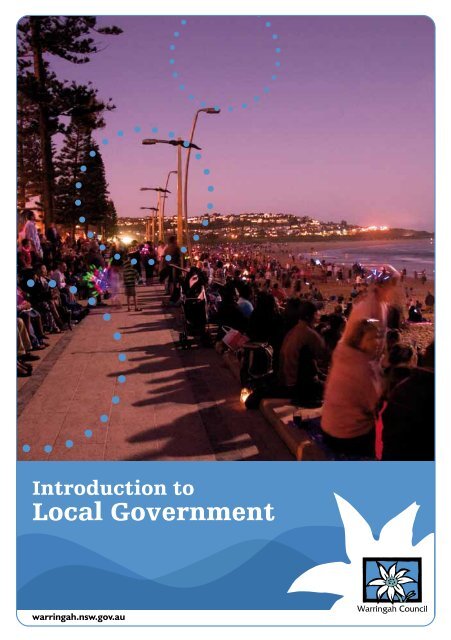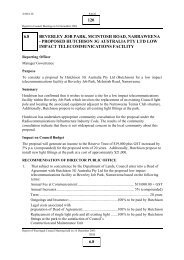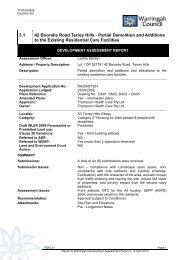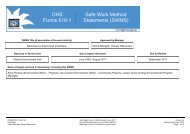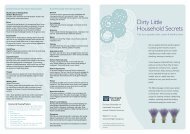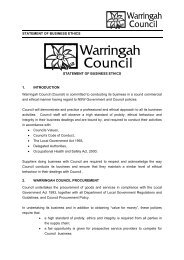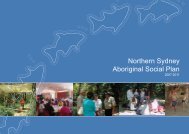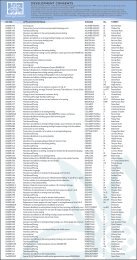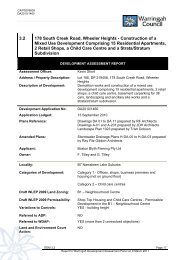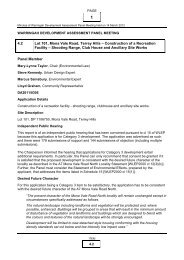Local Government - Warringah Council
Local Government - Warringah Council
Local Government - Warringah Council
You also want an ePaper? Increase the reach of your titles
YUMPU automatically turns print PDFs into web optimized ePapers that Google loves.
Introduction to<br />
<strong>Local</strong> <strong>Government</strong><br />
warringah.nsw.gov.au
Acknowledgement<br />
of Country<br />
We acknowledge that we are here today on the<br />
land of the Guringai People.<br />
The Guringai are the traditional owners of this<br />
land and are part of the oldest surviving continuous<br />
culture in the world.<br />
We pay our respects to the spirits of the<br />
Guringai People.
What is<br />
<strong>Government</strong><br />
Imagine living in a place without transport or roads.<br />
How would you get to school<br />
What would it be like if there was nobody to<br />
help look after elderly and sick people, or to keep<br />
our environment clean and safe For people to<br />
live together we need rules. <strong>Government</strong> decides<br />
what is best for the community and how to use its<br />
resources to provide the best lifestyle for members<br />
of the community. Australia’s system of government<br />
is a parliamentary democracy. Democracy means<br />
‘government by the people’. It is very difficult for<br />
people to vote on every issue so we elect individuals to<br />
decide on our behalf.<br />
In Australia we have three levels of government<br />
– federal, state and local. Australia’s national<br />
government is called the federal or commonwealth<br />
government. It decides on matters which affect the<br />
whole nation, such as foreign affairs, currency, postal<br />
and telephone services. The federal government meets<br />
in the national capital, Canberra and the leader is<br />
called the Prime Minister.<br />
How Did <strong>Local</strong> <strong>Government</strong><br />
Come About<br />
The three levels of government have developed through historical events.<br />
In 1788 the British came to Australia to set up a colony at Botany Bay. Other colonies<br />
were set up in Tasmania, South Australia, Western Australia and Queensland.<br />
Eventually the six colonies won the right to self-government and following the British<br />
system, established another level called local government. Its job was to assist in the<br />
building of local roads and other facilities.<br />
As the colonies grew, people in Australia wanted the country to become one nation.<br />
In 1901 the colonies agreed to form a new federal government to look after<br />
national issues. This was called federation. The colonial governments of the time were<br />
renamed state government and they had the new job of overseeing local government<br />
in their state.<br />
Each state has its own government. State government<br />
responsibilities include health, education, police,<br />
railways, main roads and public housing. The leader<br />
of each state government is called the Premier. State<br />
<strong>Government</strong>s meet in the capital city of their State. In<br />
NSW, the State <strong>Government</strong> meets in Sydney.<br />
<strong>Local</strong> government is the third level of government. It is<br />
responsible for smaller areas than the federal or state<br />
governments. <strong>Local</strong> government controls things such<br />
as garbage, childcare, parks, libraries, and the local<br />
environment.
Who Does What<br />
The establishment of our federal system of government is set out in the<br />
Australian Constitution Act, 1900. The constitution outlines the duties of state<br />
and federal governments.<br />
The states kept most of their powers but gave up matters of common interest such as<br />
international relations, immigration, defence and the minting of money.<br />
In NSW, local government gets its powers from the NSW <strong>Local</strong> <strong>Government</strong> Act<br />
of 1993 and the state governments oversee councils in each state.<br />
As long as councils operate under the law of the act, the state government is unlikely<br />
to interfere. However, if things do go wrong such as corruption or mismanagement,<br />
the state government may dismiss the elected councillors and appoint an administrator<br />
to fix the problem.<br />
Why <strong>Local</strong> <strong>Government</strong><br />
is Important<br />
<strong>Local</strong> government is important because communities in different parts of the country<br />
have different needs.<br />
In <strong>Warringah</strong> for example, there are many waterways, beaches and bushland. This means<br />
<strong>Warringah</strong> spends money on lifeguards, beach pollution, lagoon preservation and bush<br />
regeneration. In other councils, these issues may not be important.<br />
A local council can be made up of a group of suburbs, a town or a town and the<br />
surrounding countryside. Each council is governed by a group of people called<br />
councillors and the leader is called the Mayor.<br />
<strong>Council</strong>s provide services to meet the needs of the community. The general purpose of<br />
councils is to:<br />
• Ensure order and good government for an area<br />
• Advise and encourage appropriate building and other development in the<br />
best interests of the community<br />
• Provide and manage community services and facilities<br />
• Manage and improve natural resources and the environment
How <strong>Council</strong>s Work<br />
Map of Wards in <strong>Warringah</strong><br />
The people who live or own a property in each local government area choose who they<br />
want on their local council by voting in council elections. Elections are held every four<br />
years and any resident or ratepayer can stand for office.<br />
All residents must vote if they:<br />
• Are 18 years old or over<br />
• Are Australian citizens<br />
• Have lived in the area for at least three months<br />
• Are on the electoral roll<br />
<strong>Council</strong> areas are divided into regions known as ‘wards’. <strong>Warringah</strong> is divided into three<br />
wards and three councillors are elected for each ward.<br />
<strong>Warringah</strong>’s <strong>Council</strong>lors<br />
<strong>Council</strong>lors do not get paid for the time and service they give to the community but they<br />
do receive an allowance to help cover expenses. They stand for election because they<br />
are interested in the wellbeing of their district and generally carry out these duties on<br />
top of a full time job. <strong>Council</strong>lors are similar to a board of directors with ratepayers and<br />
residents being the shareholders.<br />
<strong>Warringah</strong>’s Mayor and <strong>Council</strong>lors
The Mayor<br />
At the elections in September 2008 nine councillors, three from each ward, and a<br />
Mayor were elected by <strong>Warringah</strong> voters. <strong>Council</strong> may also elect a Deputy Mayor who<br />
represents the Mayor when he, or she, is away.<br />
<strong>Warringah</strong>’s <strong>Council</strong>lors<br />
Ward A<br />
The Mayor presides at council meetings. If the votes for and against a proposal are<br />
equal, the Mayor has the right to give a casting or deciding vote.<br />
It is the Mayor’s duty to keep order at meetings and can have a member of the council<br />
removed if that member doesn’t behave properly.<br />
<strong>Council</strong> Meetings<br />
<strong>Warringah</strong> <strong>Council</strong> and major committee meetings<br />
are held in <strong>Council</strong> Chambers to discuss local<br />
issues and make decisions on behalf of the local<br />
community. The Mayor is the chairperson and the<br />
council’s General Manager and other staff also<br />
attend to answer questions and explain reports.<br />
Wayne Gobert Vanessa Moskal Vincent De Luca OAM<br />
Ward B<br />
Meetings are open to the public and any resident<br />
can attend.<br />
Sue Heins Bob Giltinan Pat Daley<br />
Ward C<br />
Michael Regan<br />
Michael Regan<br />
Past Mayors<br />
ELECTED TERM NAME<br />
28/9/1993 1993-1994 B GREEN<br />
20/9/1994 1994-1995 B GREEN<br />
19/9/1995 1995-1996 J SUTTON<br />
24/9/1996 1996-1997 S DANIELI<br />
23/9/1997 1997-1998 S DANIELI<br />
22/9/1998 1998-1999 J CAPUTO<br />
23/9/1999 1999-2000 P MOXHAM<br />
26/9/2000 2000-2001 P MOXHAM<br />
27/9/2001 2001-2002 D JONES<br />
26/9/2002 2002-2003 J SUTTON<br />
Roslyn Harrison Duncan Kerr Jose Menano-Pires<br />
<strong>Council</strong>lors stand for election because they are interested in the wellbeing of their<br />
district. They generally carry out their council duties on top of another job. <strong>Council</strong>lors<br />
are similar to a board of directors with ratepayers and residents being the shareholders.
History of <strong>Warringah</strong><br />
The name ‘<strong>Warringah</strong>’ was taken from the Aboriginal<br />
word for Middle Harbour.<br />
‘<strong>Warringah</strong>’ also has other meanings in various Aboriginal<br />
languages including ‘grey head’ and ‘signs of rain’.<br />
‘Garigal’ is the name of the Aboriginal clan who occupied<br />
the Manly <strong>Warringah</strong> Pittwater area on the coast.<br />
The Guringai lived in large groups throughout the region<br />
because it was so rich in food supplies such as fruit, nuts,<br />
seeds, leaves, roots, bulbs, honey, nectar, insect grubs and<br />
fish.<br />
Governor Phillip made expeditions to the northern<br />
beaches within weeks of the landing of the First Fleet.<br />
Although initial land grants occurred in the early 1800s,<br />
settlement was slow until transport links in the 1850s.<br />
European settlement resulted in the almost total<br />
destruction of Aboriginal traditional way of life. Today,<br />
you can see evidence of the Guringai’s life and culture<br />
through local Aboriginal sites.<br />
<strong>Warringah</strong>’s First <strong>Council</strong><br />
The first <strong>Council</strong> was elected in November 1906 and consisted of six councillors. The<br />
<strong>Council</strong> moved from Narrabeen to Smith’s Hall at Brookvale in December 1906. In 1973<br />
the <strong>Council</strong> moved to the new Civic Centre at Dee Why.<br />
At the time of incorporation <strong>Warringah</strong> was almost entirely a rural area with holiday<br />
resorts and a population of only 3,000 people.<br />
<strong>Warringah</strong> expanded after World War I with a lifting of building restrictions and<br />
completion of the Spit Bridge in 1924. The 1930s’ depression and inadequate transport<br />
slowed progress until 1932 when the Sydney Harbour Bridge was opened giving greater<br />
access to the peninsula. By 1933 the population had reached 16,800 and by the start of<br />
World War II it was almost 20,000.<br />
Today <strong>Warringah</strong> covers an area of 152.55 square kilometres and more then 141,000<br />
people live in <strong>Warringah</strong>.<br />
<strong>Council</strong>’s logo, the flannel flower, was adopted in 1998. The flannel flower is native to<br />
the <strong>Warringah</strong> area and blooms in late spring and early summer. This fragile but tough<br />
plant does well in times when other plants fade. It is a symbol of endurance, achievement<br />
and beauty.<br />
(Since 1907 the flannel flower has been part of <strong>Warringah</strong>’s logo and was <strong>Council</strong>’s first<br />
official seal. The logo is displayed on all the stationary, vehicles, signs, uniforms, parking<br />
stickers, advertising, publications, border signs, and any other items that fall within<br />
<strong>Council</strong>’s responsibilities.)
Map of <strong>Warringah</strong><br />
This is a map of your <strong>Local</strong> <strong>Government</strong> Area.<br />
What Your <strong>Council</strong> Does<br />
<strong>Warringah</strong> <strong>Council</strong>’s mission is to create a better and exciting <strong>Warringah</strong> through<br />
innovative leadership, partnerships and outstanding service. Its vision is:<br />
• Leading our community<br />
• Protecting our environment<br />
• Creating our future<br />
Some of the things <strong>Warringah</strong> <strong>Council</strong> looks after include:<br />
<strong>Local</strong> roads, waste, parks and foreshores, bushland, Glen Street Theatre, libraries,<br />
beaches, childcare, youth, disability and age services, the <strong>Warringah</strong> Aquatic Centre,<br />
urban planning, development assessments and companion animals.<br />
What Do <strong>Council</strong><br />
Staff Do<br />
<strong>Council</strong>s do a lot of different things to<br />
keep your local area running. However, the<br />
councillors elected to the council do not do<br />
these things themselves.<br />
Qualified and skilled staff provide reports and<br />
advice to help councillors make decisions.<br />
<strong>Warringah</strong> <strong>Council</strong> employs almost 600<br />
people. These people are not elected and are<br />
paid for their work.<br />
Staff carry out <strong>Council</strong>’s programs, according<br />
to the relevant laws and council policy which<br />
is reviewed regularly. For example, if you<br />
want to build a house in <strong>Warringah</strong> you have<br />
to follow the rules in the <strong>Warringah</strong> <strong>Local</strong><br />
Environmental Plan.
Where Does the<br />
Money Come From<br />
In all levels of government much of the decision<br />
making is about where money should be spent in<br />
the community and how to raise the finance to carry<br />
out required tasks.<br />
The work council does costs money. It must buy<br />
machines and vehicles for roadwork; materials to<br />
build roads and bridges; books for the libraries;<br />
maintain parks and swimming pools; and pay<br />
wages to its staff.<br />
<strong>Warringah</strong> has an annual budget of approximately<br />
$170 million to provide all the facilities and services<br />
in the local community. <strong>Council</strong> has many ways to<br />
raise the money to pay for its work.<br />
Much of a council’s money comes from taxes on<br />
land called rates. Each year the owners of houses<br />
or other property must pay rates to the council.<br />
<strong>Council</strong>s also charge fees for some of the services<br />
they provide, like swimming at council pools.<br />
<strong>Council</strong>s also receive money from the state and<br />
federal governments. These are called grants.<br />
Geography<br />
<strong>Warringah</strong> is mainly an urban area, although<br />
it still has large tracts of land which remain<br />
undeveloped. The bush and beaches in<br />
<strong>Warringah</strong> are major attractions.<br />
Bush<br />
Bushland is a significant feature of <strong>Warringah</strong>.<br />
Presently, 28 per cent of <strong>Warringah</strong> is bushland.<br />
There are 19 types of bush in <strong>Warringah</strong><br />
including heathland communities to the<br />
sheltered rainforest gullies, to open forest<br />
and grasslands.<br />
Beach<br />
<strong>Warringah</strong>’s coastline is 14 kilometres long and<br />
includes nine beaches stretching from North<br />
Narrabeen Beach at the entrance of Narrabeen<br />
Lagoon to Freshwater Beach in the south.<br />
The present coastline of <strong>Warringah</strong> was formed<br />
over many thousands of years as a result of<br />
erosion and deposition that took place as sea<br />
level fluctuated.
Looking After the Environment<br />
The care and protection of our native<br />
flora and fauna is of major concern to<br />
<strong>Warringah</strong> <strong>Council</strong>. Urbanisation and<br />
environmental changes have disturbed<br />
and reduced the quality of our remnant<br />
bushland. Vegetation removal, domestic<br />
feral animals, dumped garden rubbish,<br />
increased stormwater runoff, changed<br />
fire regimes and vandalism have led to<br />
weed invasion in our bushland by exotic<br />
species such as lantana and privet.<br />
<strong>Council</strong> is responsible for maintaining<br />
and improving public property which<br />
includes places such as roads, bridges,<br />
parks, playing fields and footpaths. This<br />
involves building and repairing roads<br />
and public works, preserving the area<br />
and waste disposal.<br />
Aboriginal Sites<br />
<strong>Warringah</strong> has many valuable<br />
Aboriginal cultural and heritage<br />
sites such as rock engravings, rock<br />
art, open campsites, rock shelters,<br />
scarred trees and middens.<br />
It is important to respect and<br />
protect them because they provide<br />
a historical link to the traditional<br />
owners of the Manly <strong>Warringah</strong><br />
Pittwater area. The people who<br />
lived here before European<br />
settlers belonged to the ‘Garigal’<br />
Aboriginal clan.<br />
The NSW National Parks and<br />
Wildlife Service is responsible<br />
for protecting and preserving<br />
Aboriginal sites in NSW. It is<br />
illegal to damage or destroy an<br />
Aboriginal relic.
<strong>Warringah</strong> at a Glance<br />
Area<br />
153 square kms<br />
Population<br />
146,000<br />
<strong>Council</strong>’s forecast 2012/13 expenditure<br />
$173 million<br />
<strong>Council</strong> assets<br />
$3.3 billion<br />
Suburbs 27<br />
Properties 54,711<br />
Patrolled beaches 9<br />
Beach patrol rescues during 2011/12 beach season 1,146<br />
First aid actions during 2011/12 beach season 2,503<br />
Visitors to <strong>Warringah</strong>’s beaches during 2011/12 beach season 2.5 million<br />
Number of parks and reserves maintained by <strong>Council</strong> 421<br />
Customer service inquiries per month 14,000<br />
Bins emptied daily 600<br />
Street name signs replaced 2011/12 656<br />
Bookings taken for <strong>Council</strong>’s vacation care 2011/12 9,749<br />
Children who perform at Glen Street Theatre per year 6,000<br />
Graffiti removal jobs 2011/12 8,603<br />
Contact Us<br />
warringah.nsw.gov.au<br />
9942 2111<br />
facebook.com/warringahcouncil<br />
twitter.com/mywarringah
warringah.nsw.gov.au


